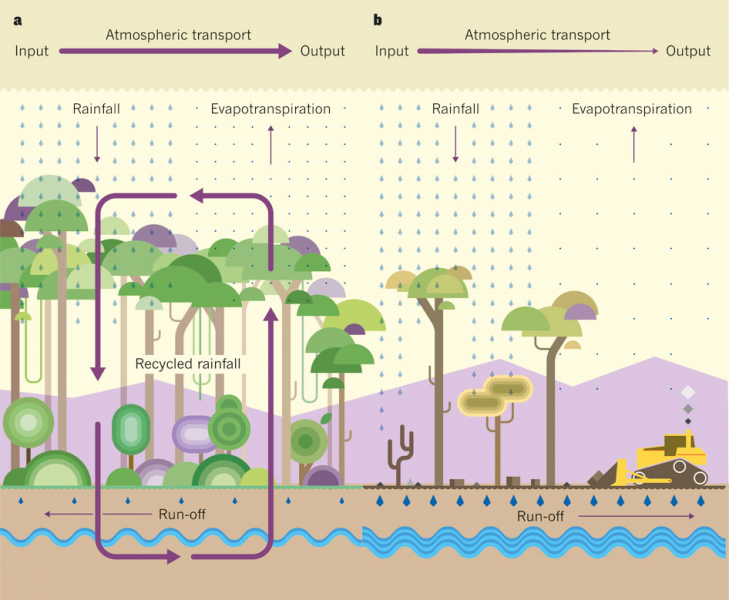There is some evidence to suggest that loss of tree cover on Mediterranean hill slopes has altered weather patterns, which in turn have altered precipitation amount and timing. Modelling results suggest that Mediterranean precipitation regimes are very sensitive to variations in air temperature and moisture. Land use change and associated deforestation may have led to changes from and open monsoon-type regime with frequent summer storms over inland mountains to a regime dominated by closed vertical atmospheric recirculation where feedback mechanisms suppress storms over the coastal mountains and lead to increased summer time sea surface warming. This warming leads to torrential rains in autumn and winter. These rains can occur across the Mediterranean basin. This can be exacerbated by greenhouse heating associated with air pollutants. Targeted afforestation in some parts of the Mediterranean may be one means of combating drought and desertification. However, caution should be taken when choosing areas for afforestation to avoid possible adverse effects, as there is some evidence that afforestation in dry environments, especially in montane areas, may decrease water yield and cause water deficit in the downstream rivers. Local tree species should be used to reduce risks to biodiversity.

Functioning of the water cycle in forests
Source: http://www.nature.com/nature/journal/v489/n7415/full/nature11485.html?WT.ec_id=NATURE-20120913
| Benefits | Level |
|---|---|
|
BP2 - Slow runoff
|
High
|
|
BP1 - Store runoff
|
High
|
|
BP5 - Increase evapotranspiration
|
Medium
|
|
BP6 - Increase infiltration and/or groundwater recharge
|
Medium
|
|
BP7 - Increase soil water retention
|
Medium
|
|
BP10 - Reduce erosion and/or sediment delivery
|
Medium
|
|
BP8 - Reduce pollutant sources
|
Medium
|
|
BP9 - Intercept pollution pathways
|
Medium
|
|
BP11 - Improve soils
|
Medium
|
|
BP13 - Create riparian habitat
|
Low
|
|
BP14 - Create terrestrial habitats
|
Medium
|
|
BP15 - Enhance precipitation
|
High
|
|
BP16 - Reduce peak temperature
|
Medium
|
|
BP17 - Absorb and/or retain CO2
|
Medium
|
|
ES1 - Water storage
|
High
|
|
ES3 - Natural biomass production
|
High
|
|
ES4 - Biodiversity preservation
|
Medium
|
|
ES5 - Climate change adaptation and mitigation
|
High
|
|
ES6 - Groundwater/aquifer recharge
|
High
|
|
ES7 - Flood risk reduction
|
Medium
|
|
ES8 - Erosion/sediment control
|
High
|
|
ES9 - Filtration of pollutants
|
High
|
|
ES10 - Recreational opportunities
|
High
|
|
ES11 - Aesthetic/cultural value
|
High
|
|
PO1 - Improving status of biology quality elements
|
Medium
|
|
PO2 - Improving status of physico-chemical quality elements
|
Low
|
|
PO3 - Improving status of hydromorphology quality elements
|
Low
|
|
PO4 - Improving chemical status and priority substances
|
Low
|
|
PO5 - Improving quantitative status
|
Low
|
|
PO6 - Improving chemical status
|
Low
|
|
PO7 - Prevent surface water status deterioration
|
Low
|
|
PO8 - Prevent groundwater status deterioration
|
Low
|
|
PO9 - Take adequate and co-ordinated measures to reduce flood risks
|
Medium
|
|
PO10 - Protection of important habitats
|
Low
|
|
PO11 - Better protection for ecosystems and more use of Green Infrastructure
|
Medium
|
|
PO12 - More sustainable agriculture and forestry
|
Medium
|
|
PO14 - Prevention of biodiversity loss
|
Medium
|